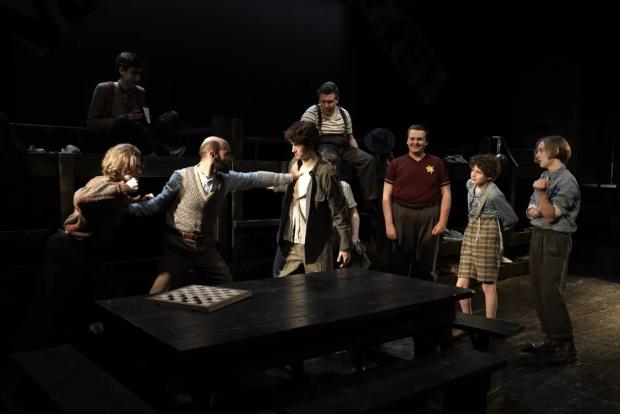Advertisement
As that sixties’ saying puts it, “the personal is political.” In the case of The Last Boy, which is being presented April 27 on Holocaust Remembrance Day at the renowned Town Hall in Midtown Manhattan’s Theater District, the personal is political and also theatrical to me. That’s because this timely fact-based anti-Nazi drama stars my 21-year-old cousin, who is making an auspicious Broadway debut.
Bret Sherman portrays the title character in The Last Boy, which is “about a group of seven boys who are in the Terezin camp in Czechoslovakia,” notes Sherman. “They are living through this terrible, dark time. But the playwright/director, Steve Fisher, does a really great job of not dwelling on that too much, of the miserable atmosphere they’re a part of. Because at the end of the day, while we can look back at it now and realize that was such a terrible time, and I’m sure the boys realized they were being mistreated, but they obviously didn’t have a ton of information and I don’t think they understood the scope of what was happening,” as Hitler’s “final solution” exterminated millions of Jews and others during World War II.
Terezin, also known as Theresienstadt, was located 30 miles north of Prague. According to http://www.terezin.org/the-history-of-terezin: “More than 150,000 Jews were sent there, including 15,000 children, and held there for months or years, before being sent by rail transports to their deaths at Treblinka and Auschwitz extermination camps in occupied Poland, as well as to smaller camps elsewhere. Less than 150 children survived” at what was a mixture of ghetto and concentration camp. Although largely set during the 1940s, with today’s resurgence of hate crimes, growing threat of totalitarianism, distrust of news media as “the enemy of the people” and scenes of carnage and combat from Ukraine not seen in Europe since WWII The Last Boy remains, alas, startlingly relevant.
In a sense, “information” is at the heart of this play “inspired by the incredible story of the boys in Terezin Concentration Camp’s Dorm Number 1, who created the longest-running underground publication of the Holocaust. Every Friday night, the teenage residents of the room would gather in secret to read aloud poems and prose they had written that week. In this way, 80 editions made up of 800 pages of manuscript were ‘published’ – they did not make copies, for security reasons. ‘If their magazine (called Vedem, or ‘we are leading’ in Czech) had been discovered, the entire room surely would have been immediately transported to Auschwitz,’ says playwright Steve Fisher,” according to the website for the New Jersey-based Academy for the Performing Arts (APA), where Sherman studied acting before attending Elon University in North Carolina.
Sherman, who was interviewed at NJ by phone, adds, “Over the course of two years 100 boys passed through the dorm. At any one time, 40 boys lived in the dorm.” The typed and then handwritten (when the typewriter ribbon wore out) issues of the Czech-language Vedem included short stories, poetry, riddles, accounts of daily life, jokes, quizzes, artwork and “was headed by the character Jakub in the play,” says Sherman. “My character, who is named Matyas, is against the magazine, which he thinks is incredibly dangerous. He was not only the last boy but also the first boy at the camp. He had been there the longest, and sees Vedem as a target the boys are putting on their backs.”
Sherman goes on to say, “Jakub sees it as an expression when they’re in such a terrible situation, they want to express their feelings, and Jakub thinks the best way to do it is through the magazine… According to the script, Vedem had physical pages, they had an editor, weekly submissions.” As http://vedem-terezin.cz/en/home_en.html points out, the editor-in-chief’s actual name was Petr Ginz, who was eventually gassed at Auschwitz.
“Fourteen of the play’s 16 characters are boys. There are seven main characters. Statistically, only one of those seven would have survived the war. Matyas is that one,” laments Sherman, explaining that The Last Boy “takes place during two time periods, the 1940s, when the boys are imprisoned and the 1970s, with the 25th anniversary of the liberation of Terezin [in May 1945 by the Red Army] and Matyas digs Vedem up. Because right before they got liberated, he was smart enough to bury the magazine, which is incredible… He wanted the boys’ memories to live on.” The account is reminiscent of how Miep Gies, one of the righteous Dutch residents who helped conceal Anne Frank and her family, retrieved Anne’s Diary after the Nazis caught the Jews at their hiding place, and eventually gave the immortal journal to Anne’s father, Otto.
New Jersey-born Sherman is graduating with a BFA in Acting this May from Elon University in North Carolina. On the big and little screen, Sherman has been an extra in Steven Spielberg’s West Side Story and Amazon’s The Marvelous Mrs. Maisel, and featured in a national car commercial. On the boards, Sherman has played principal and supporting roles, including Giggles in Adam Szymkowicz’s Clown Bar and a witch in Shakespeare’s Macbeth.
In addition to reading, Sherman’s research for his star role included speaking with Shoah survivors, including the play’s eponymous real life last boy, actually named “Sidney Taussig and Michael Gruenbaum, author of Somewhere There is Still a Sun, which recounts his experience during the Holocaust.” Sherman describes encountering the real life individual he depicts as “incredibly humbling, and inspiring. You read the script and there’s a little part of you that says, ‘there’s no way that this could have happened at such a young age,’ and then you meet with survivors. Their memories are still so sharp and they remember so much. It really puts your life in perspective – wow! My life compared to that situation is so easy. It gives another dimension to how I approached playing the character. Everyone has their own motive, goal and storyline,” muses the young American Jew.
Sherman adds: “When talking with survivors, and the director/playwright, the only times they remember crying was when they were hungry. They were never crying because of their situation. The boy my character is based on, Sidney Taussig, was an absolute prodigy at soccer, that was his thing. At the camp, each dorm had a team and they’d play against one another. Obviously, life wasn’t normal but there were some things that children still do today.”
The full name of the production – which previously played Off-Broadway in July 2021 as NYC’s first post-pandemic world premiere (according to http://thetownhall.org), winning four Broadway World Awards: Best New Play, Best Production, Best Direction, and Best Performance – is The Last Boy… a new play with music. “It’s a play with a lot of music and poetry,” says Sherman. “Music is a big part of it, whether it’s Matyas who plays the piano or he tries to play the violin. That was a big way of expressing their feeling. Song is a big cultural thing, obviously, in the Jewish community. There are references to Dvořák and other great composers.” Sherman himself doesn’t actually tickle the ivories during the show, which has, offstage, a live pianist plus a player of the heligonka, a Czech accordion-like instrument.
The actor states that “1.5 million young people perished in the Holocaust, and lots of times, people just remember the number, the grand scale of how big and how many people that is. We want their stories to live on and making sure they’re remembered as individuals,” says Sherman, who was attracted to audition for the play when he read about it in Backstage, because “it had to do with Jewish themes, which is an important value of mine… It’s important to never forget, and I think people are already forgetting with the rise of misinformation and ‘fake news.’ It’s incredibly important and empowering to continue to tell the story… I definitely think that if [the story of the Holocaust] doesn’t get told, it will be lost to history.”
According to the APA website: “On April 27th, the play will be featured at a one-night only benefit performance to commemorate Yom HaShoah [Holocaust Remembrance Day]. The evening is serving as a benefit for several non-profit [Jewish] organizations. The curtain will rise on April 27th at 6:00 p.m. on Sherman and his fellow 17 cast members… The show will end precisely at sunset – the start of Yom HaShoah. At that moment, 100 young audience members will rise from the audience with a candle in hand, representing all 100 boys who passed through Dorm Number 1. Several of those young people are grandchildren of survivors, who will be present as honored guests. Our 6 Million, an Israel based non-profit whose mission is to remember by name all those who perished in the Shoah, is partnering with the April 27th event so that every audience member also has a candle in hand. On each candle will be the name of a child who perished in Terezin.”
Sherman indicates that for the one-time benefit performance, the play is edited down to 90-minutes and being staged in a one-act format at Manhattan’s prestigious Town Hall, which was established between Broadway and Sixth Avenue in 1921 by the pro-suffragette The League for Political Education. Since then, the venerable venue has been a showcase for the arts, featuring luminaries such as Pablo Casals, Paul Robeson, Sergei Rachmaninov, Marian Anderson, Andres Segovia, Charlie Parker, Dizzy Gillespie, Igor Stravinsky, Duke Ellington, Bob Dylan, Billie Holiday, Ravi Shankar, et al.
In addition, the Georgian Revival style performance space has also served as a key platform for cutting edge ideas. On Nov. 13, 1921, Planned Parenthood founder Margaret Sanger was arrested for publicly discussing birth control on Town Hall’s stage, where a memorial for the executed anarchists Sacco & Vanzetti took place 1929, Emma Goldman held forth on anarchy and Hitler in 1934, poet Langston Hughes discussed racism in 1944, as did Fannie Lou Hamer in a SNCC-sponsored 1964 event, etc. One of Town Hall’s most famous – or infamous – debates featured author Norman Mailer facing off against feminists, including Germaine Greer, on April 30, 1971 in what came to be known as “Town Bloody Hall.”
The Last Boy arguably combines Town Hall’s artistic and philosophical heritage. With its dramatization of historic, tragic events, this benefit production of The Last Boy seems likely to be a very memorable way to remember Holocaust Remembrance Day – and also the Broadway premiere of Bret Sherman, who promises to be a force to be reckoned with on the stage and screen in the years to come.
Theatre 4 Young People presents the benefit performance of The Last Boy… a new play with music at 6:00 p.m. on April 27, doors open at 5:00 p.m. at 123 West 43rd Street, New York, NY 10036. For info and tickets: http://thetownhall.org/event/the-last-boy-a-new-play-with-music; (212)997-6661. See: https://bretsherman.com/.






